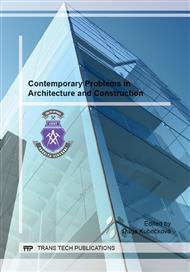[1]
T. Nitkiewicz, the tools of implementing sustainability in business sector, in: V. Modrák, T. Nitkiewicz (Eds. ), The role of business in achieving sustainability. Part 1: Instruments and Strategies, Techn. Univ. Kosice, Presov 2010, pp.7-25.
Google Scholar
[2]
L. Zhou, H. Tokos, D. Krajnc, Y. Yang, Sustainability performance evaluation in industry by composite sustainability index, Clean Techn. Environ. Policy 14 (2012) 789–803.
DOI: 10.1007/s10098-012-0454-9
Google Scholar
[3]
A. Gunasekaran, A. Spalanzani, Sustainability of manufacturing and services: Investigations for research and applications, Int. J. Production Economics 140 (2012) 35–47.
DOI: 10.1016/j.ijpe.2011.05.011
Google Scholar
[4]
A. Fuertes, M. Casals, M. Gangolells, N. Forcada, M. Macarulla, X. Roca, An Environmental Impact Causal Model for improving the environmental performance of construction processes, Journal of Cleaner Production 52 (2013) 425-437.
DOI: 10.1016/j.jclepro.2013.02.005
Google Scholar
[5]
D.T.H. Giang, L. Sui Pheng, Role of construction in economic development: Review of key concepts in the past 40 years, Habitat International 35 (2011) 118-125.
DOI: 10.1016/j.habitatint.2010.06.003
Google Scholar
[6]
A. Tischer, M. Besiou, C. -A. Graubner, Efficient waste management in construction logistics: a refurbishment case study, Logist. Res. 6 (2013) 159–171.
DOI: 10.1007/s12159-013-0105-5
Google Scholar
[7]
E. Milutiené, J.K. Staniškis, A. Kručius, V. Auguliené, D. Ardickas, Increase in buildings sustainability by using renewable materials and energy, Clean Techn. Environ. Policy 14 (2012) 1075–1084.
DOI: 10.1007/s10098-012-0505-2
Google Scholar
[8]
P.O. Akadiri, P.O. Olomolaiye, E.A. Chinyio, Multi-criteria evaluation model for the selection of sustainable materials for building Project, Automation in Construction 30 (2013) 113–125.
DOI: 10.1016/j.autcon.2012.10.004
Google Scholar
[9]
R. Mateus, S. Neiva, L. Bragança, P. Mendonça, M. Macieira, Sustainability assessment of an innovative lightweight building technology for partition walls - Comparison with conventional technologies, Building and Environment 67 (2013) 147-159.
DOI: 10.1016/j.buildenv.2013.05.012
Google Scholar
[10]
X. Zhanga, Y. Wub, L. Shen, Application of low waste technologies for design and construction: A case study in Hong Kong, Renewable and Sustainable Energy Reviews 16 (2012) 2973– 2979.
DOI: 10.1016/j.rser.2012.02.020
Google Scholar
[11]
H. Yuan, A SWOT analysis of successful construction waste management, Journal of Cleaner Production 39 (2013) 1-8.
Google Scholar
[12]
B. Vandecasteele, J. Heynen, H. Goumans, Materials Recycling in Construction: A Review of the Last 2 Decades Illustrated by the WASCON Conferences, Waste Biomass Valor 4 (2013) 695–701.
DOI: 10.1007/s12649-013-9239-6
Google Scholar
[13]
S.K. Lachimpadi, J.J. Pereira, M.R. Taha, M. Mokhtar, Construction waste minimisation comparing conventional and precast construction (Mixed System and IBS) methods in high-rise buildings: A Malaysia case study, Resources, Conservation and Recycling 68 (2012).
DOI: 10.1016/j.resconrec.2012.08.011
Google Scholar
[14]
S. -H. Kwon, K.J. Kim, K. Kim, N. Cho, Assessment Model on Environmental Economics for Construction Projects in Korea, KSCE Journal of Civil Engineering 16(4) (2012) 505-516.
DOI: 10.1007/s12205-012-1363-5
Google Scholar
[15]
M. Kucukvar, O. Tatari, Towards a triple bottom-line sustainability assessment of the U.S. construction industry, Int J Life Cycle Assess 18 (2013) 958–972.
DOI: 10.1007/s11367-013-0545-9
Google Scholar
[16]
Y. Tan, L. Shen, H. Yao, Sustainable construction practice and contractors' competitiveness: A preliminary study, Habitat International 35 (2011) 225-230.
DOI: 10.1016/j.habitatint.2010.09.008
Google Scholar
[17]
C. Koranda, W.K. Chong, C. Kim, J. -S. Chou, C. Kim, An Investigation of the Applicability of Sustainability and Lean Concepts to Small Construction Projects, KSCE Journal of Civil Engineering 16(5) (2012) 699-707.
DOI: 10.1007/s12205-012-1460-5
Google Scholar
[18]
Q. Shi, J. Zuo, R. Huang, J. Huang, S. Pullen, Identifying the critical factors for green construction - An empirical study in China, Habitat International 40 (2013) 1-8.
DOI: 10.1016/j.habitatint.2013.01.003
Google Scholar
[19]
H. -S. Jang, S. -I. Choi, W. -Y. Kim, C. -K. Chang, Strategic Selection of Green Construction Products, KSCE Journal of Civil Engineering 16(7) (2012) 1115-1122.
DOI: 10.1007/s12205-012-1825-9
Google Scholar
[20]
Environment 2004 and 2013, Central Statistical Office, Publication available on website www. stat. gov. pl.
Google Scholar


